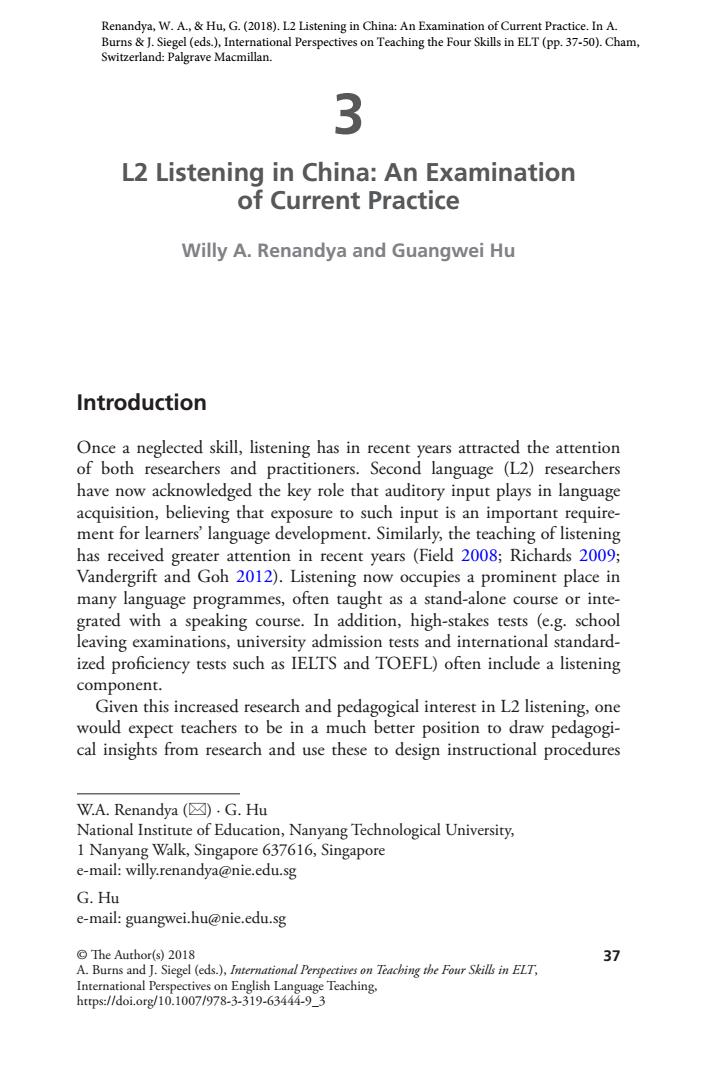正在加载图片...

Renandya,W. A.,& Hu, G.(2018). L2 Listening in China: An Examination of Current Practice. In A. Burns &J. Siegel(eds.), International Perspectives on Teaching the Four Skills in ELT(pp. 37-50).Cham Switzerland: Palgrave Macmillan. 3 L2 Listening in China: An Examination of Current Practice Willy A. Renandya and Guangwei Hu Introduction Once a neglected skill, listening has in recent years attracted the attention of both researchers and practitioners. Second language(L2) researchers have now acknowledged the key role that auditory input plays in language acquisition, believing that exposure to such input is an important require- ment for learners' language development. Similarly, the teaching of listening has received greater attention in recent years (Field 2008; Richards 2009; Vandergrift and Goh 2012). Listening now occupies a prominent place in many language programmes, often taught as a stand-alone course or inte- grated with a speaking course. In addition, high-stakes tests (e.g. school leaving examinations, university admission tests and international standard- ized proficiency tests such as IELTS and TOEFL) often include a listening component. Given this increased research and pedagogical interest in L2 listening, one would expect teachers to be in a much better position to draw pedagogi- cal insights from research and use these to design instructional procedures W.A. Renandya().G. Hu National Institute of Education, Nanyang Technological University, 1 Nanyang Walk, Singapore 637616, Singapore e-mail:willy.renandya@nie.edu.sg G. Hu e-mail:guangwei.hu@nie.edu.sg C The Author(s)2018 37 A. Burns and J. Siegel (eds.), International Perspectives on Teaching the Four Skils in ELT, International Perspectives on English Language Teaching. https:/doi.org/10.1007/978-3-319-63444-9_3© Te Author(s) 2018 37 A. Burns and J. Siegel (eds.), International Perspectives on Teaching the Four Skills in ELT, International Perspectives on English Language Teaching, https://doi.org/10.1007/978-3-319-63444-9_3 Introduction Once a neglected skill, listening has in recent years attracted the attention of both researchers and practitioners. Second language (L2) researchers have now acknowledged the key role that auditory input plays in language acquisition, believing that exposure to such input is an important requirement for learners’ language development. Similarly, the teaching of listening has received greater attention in recent years (Field 2008; Richards 2009; Vandergrift and Goh 2012). Listening now occupies a prominent place in many language programmes, often taught as a stand-alone course or integrated with a speaking course. In addition, high-stakes tests (e.g. school leaving examinations, university admission tests and international standardized profciency tests such as IELTS and TOEFL) often include a listening component. Given this increased research and pedagogical interest in L2 listening, one would expect teachers to be in a much better position to draw pedagogical insights from research and use these to design instructional procedures 3 L2 Listening in China: An Examination of Current Practice Willy A. Renandya and Guangwei Hu W.A. Renandya (*) · G. Hu National Institute of Education, Nanyang Technological University, 1 Nanyang Walk, Singapore 637616, Singapore e-mail: willy.renandya@nie.edu.sg G. Hu e-mail: guangwei.hu@nie.edu.sg Renandya, W. A., & Hu, G. (2018). L2 Listening in China: An Examination of Current Practice. In A. Burns & J. Siegel (eds.), International Perspectives on Teaching the Four Skills in ELT (pp. 37-50). Cham, Switzerland: Palgrave Macmillan